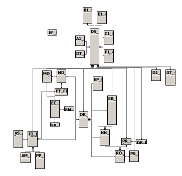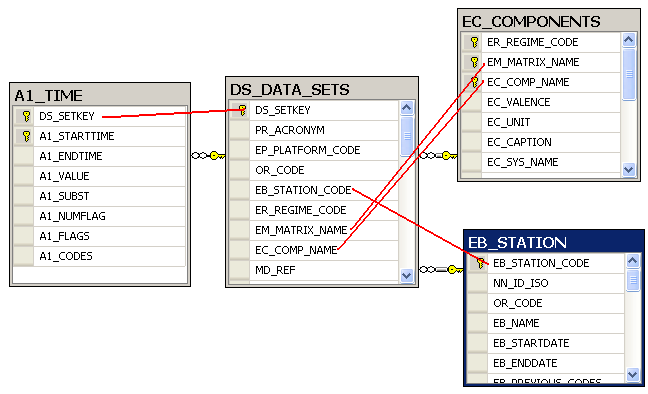Difference between revisions of "Encoding Relational Tables in NetCDF"
| Line 66: | Line 66: | ||
variables: | variables: | ||
char station_code(station, station_code_length) ; | char station_code(station, station_code_length) ; | ||
| − | + | ''table_name = "station"''; | |
| − | + | ''primary_key = "T"''; | |
float lon(station) ; | float lon(station) ; | ||
| − | + | ''table_name = "station"''; | |
float lat(station) ; | float lat(station) ; | ||
| − | + | ''table_name = "station"''; | |
'''int time(time) ;''' | '''int time(time) ;''' | ||
| − | ''' | + | '''table_name = "time";''' |
| − | ''' | + | '''primary_key = "T";''' |
== Encoding Relations == | == Encoding Relations == | ||
Revision as of 13:37, August 31, 2011
Back to Questions and Comments about CF-1.6 Station Data Convention
Rational Behind this Proposal
The WCS service has potential to grow beyond regular, gridded coverages. Coverage types that need to be described are for example:
- station point data
- station trajectory data
- lidar data
- moving station data, like aeroplane or ship
With a relational system, it is easy to design a schema that captures all the data and the metadata.
The netCDF data format was designed to contain mainly gridded multidimensional data. The format does not have a special support for tables, which sounds like a severe restriction, but it's not.
- It's possible to agree about a simple way to encode tables in a netCDF file.
- Tables with multiple fields.
- Proper primary keys for tables.
- Foreign keys for referential integrity.
- Common relationships: many-to-many, 1-to-many, 1-to-1.
- It's possible to be efficient, the encoding does not have to be one size fits all.
- Sparse tables can be encoded row-by-row manner.
- Dense tables can be encoded as multidimensional hypercubes.
- Mix and match the two above at will.
- It's possible to be elegant.
- No mysterious indirections.
- No complex offset calculations.
- A reader-writer library can take care of following the rules, letting a programmer to operate on higher level.
In the examples, table names are omitted in attribute declaration for clarity.
Encoding Table Columns
Table is a collection of columns. These are indicated with table_name attribute.
Every table needs a primary key. It is indicated with primary_key = "T" attribute.
Example: A station table with three columns: station_code, lat and lon. There are ten rows with indexes 0..9
dimensions:
station = 10 ; // station table dimension
station_code_length = 4 ; // artificial dimension for station code, with max four character length.
variables:
char station_code(station, station_code_length) ;
table_name = "station";
primary_key = "T";
float lon(station) ;
table_name = "station";
float lat(station) ;
table_name = "station";
The dimension name station can be anything. It does not have to equal the table name station, but should be for readability. Same for station_code_length, it can be called anything.
A table can have multiple fields as a primary key.
Encoding Multiple Tables
Adding the second table is similar. Since new data is usually added by time, it can be made the unlimited dimension.
dimensions:
station = 10 ; // station table dimension
station_code_length = 4 ; // artificial dimension for station code, with max four character length.
time = UNLIMITED ;
variables:
char station_code(station, station_code_length) ;
table_name = "station";
primary_key = "T";
float lon(station) ;
table_name = "station";
float lat(station) ;
table_name = "station";
int time(time) ;
table_name = "time";
primary_key = "T";
Encoding Relations
A typical station data instance is a relation (station_code, time, temperature, humidity). The pair (station_code, time) is the primary key; data is recorded at a certain station, at a certain time. Temperature and humidity are the recorded parameters.
Encoding this into netCDF can be done in two ways, using either variable or a dimension.
Encoding Relation as a Record Array
So far we have the two unrelated tables for our two dimensions: location and time. Now let's add humidity and temperature, which refers to both of the dimensions:
dimensions:
station = 10 ; // station table dimension
station_code_length = 4 ; // artificial dimension for station code, with max four character length.
data = UNLIMITED // each row in the data table.
time = 2000 ; we can't have two unlimited dimensions.
variables:
char station_code(station, station_code_length) ;
station_code:table_name = "station";
station_code:primary_key = "T";
float lon(station) ;
lon:table_name = "station";
float lat(station) ;
lat:table_name = "station";
int time(time) ;
time:table_name = "time";
time:primary_key = "T";
int data_station_code(data) ;
data_station_code:table_name = "data";
data_station_code:foreign_key = "station_code";
data_station_code:primary_key = "T";
int data_time(data) ;
data_time:table_name = "data";
data_time:foreign_key = "time";
data_time:primary_key = "T";
float temperature(data) ;
temperature:table_name = "data";
float humidity(data) ;
humidity:table_name = "data";
The variable data_station_code is marked foreign_key = "station_code", which means, that the variable is an index to the station_code variable. Similar for time. Both are marked primary_key = "T" which means, that the combination of (data_station_code, data_time) is unique.
To read the full table (station_code, lat, lon, time, temperature, humidity), row by row:
for idx in range of data
read station:
read data_station_code(idx)
read variables station_code, lat and lon at that index
read time:
read data_time(idx)
read variable time at that index
read temperature(idx)
read humidity(idx)
This is an space-efficient encoding for sparse tables.
Encoding Relation as a Multidimensional Array
This is identical to CF-1.6 encoding. Both variables are 2-dimensional cubes.
dimensions:
station = 10 ; // station table dimension
station_code_length = 4 ; // artificial dimension for station code, with max four character length.
time = UNLIMITED ; // we can again add one time slice at a time
variables:
char station_code(station, station_code_length) ;
station_code:table_name = "station";
station_code:primary_key = "T";
float lon(station) ;
lon:table_name = "station";
float lat(station) ;
lat:table_name = "station";
int time(time) ;
time:table_name = "time";
time:primary_key = "T";
float temperature(time,station) ;
temperature:table_name = "data";
float humidity(time,station) ;
humidity:table_name = "data";
This declares two arrays, one for temperature and one for humidity. Both are two-dimensional. The dimensions time and station refer to the time and station variables. They implicitly became part of the primary key.
To find temperature at "ACAD" in "2004-17-22":
Find index for "ACAD" from the "station_code" array. Let's say it's 2.
Find index for "2004-17-22" from the time array. Lets say it's 317.
Read temperature(317,2)
This is a very space-efficient encoding, if most of the stations have data most of the time.
Summa Summarum
- A typical schema of any relational database can be encoded.
- If the data is sparse, foreign keys can be expressed as variables.
- If the data is dense, foreign keys can be expressed as dimensions, resulting in vastly smaller files than flat CSV would be.
- There can be any combination of the two, enabling the best of both worlds whatever your data will look like.
More Real World Examples
These examples are not full real-life examples of real live databases, but rather examples how to encode a typical schema. The center is usually the data table, and the data record refers to the auxliary metadata tables. Typically cases are a star or a snowflake schema.
CIRA / VIEWS
All the data is stored at the center table AirData3.
TODO:
NILU / EBAS
Full Schema
The EBAS database schema is rather large, full schema outline looks like this:
Essential Schema
The essential schema is not that big, only four tables.
The essential four tables are:
- Table EB_STATION: This contains the essential of the station information.
- Field EB_STATION_CODE is the unique code.
- Fields for lat, lon, alt; some miscellaneous fields about the history of the station.
- Table EC_COMPONENTS: This table contains the measured parameters. Fields EM_MATRIX_NAME and EC_COMP_NAME define what is being measured.
- Field EM_MATRIX_NAME defines which medium the parameter is measured in (e.g. precipitation, air, pm10, ...)
- Field EC_COMP_NAME is the name of the parameter (e.g. sulphate_total, ...)
- Various other fields, like EC_UNIT define more metadata.
- Table DS_DATA_SET describes what is called a dataset in EBAS: One parameter measured at a certain station. The full version has some more complex dependecies on instrument, method etc.
- Fields EM_MATRIX_NAME and EC_COMP_NAME refer to the EC_COMPONENTS table.
- Fields DS_STARTDATE and DS_ENDDATE provide the timestamp of the first and last measurement in the timeseries.
- There are many other fields and references to many other tables.
You can imagine a dataset as an instrument on a fixed location measuring one parameter. This leads us to the main data table.
- Table A1_TIME Contains all the observations, all the parameters from all the stations
- Field DS_SETKEY refers to the dataset.
- Fields A1_STARTTIME and A1_ENDTIME define the measurement time.
- Field A1_VALUE contains the data value
- The rest of the fields are metadata.
Reading EBAS Data
So a single data row from A1_TIME can be interpreted as follows:
- The observation value is A1_VALUE
- The observation time is (A1_STARTTIME to A1_ENDTIME)
- The observation dataset is found with DS_SETKEY from DS_DATA_SET table.
- The DS_DATA_SET contains EM_MATRIX_NAME and EC_COMP_NAME that define the observation parameter.
- Field EB_STATION_CODE is the unique code refers to the observation station.
Encoding a Subset of Fields in netCDF
This shows encoding a small subset of the essential schema.
dimensions:
EB_STATION = 120
EB_STATION_CODE_length = 7
EB_NAME_length = 40
EC_COMPONENTS = 14
EM_MATRIX_NAME_length = 40
EC_COMP_NAME_length = 100
EC_UNIT_length = 8
DS_DATA_SETS = 530 // all the 120 * 14 datasets don't exist.
DS_SETKEY_length = 10
PR_ACRONYM_length = 10
A1_TIME = UNLIMITED
variables:
// fields for table EB_STATION
char EB_STATION_CODE(EB_STATION,EB_STATION_CODE_length)
table_name = "EB_STATION"
primary_key = "T"
char EB_NAME(EB_STATION,EB_NAME_length)
table_name = "EB_STATION"
float EB_LONGITUDE(EB_STATION)
table_name = "EB_STATION"
float EB_LATITUDE(EB_STATION)
table_name = "EB_STATION"
etc...
// fields for table EC_COMPONENTS
char EM_MATRIX_NAME(EC_COMPONENTS,EM_MATRIX_NAME_length)
table_name = "EC_COMPONENTS"
primary_key = "T"
char EC_COMP_NAME(EC_COMPONENTS,EC_COMP_NAME_length)
table_name = "EC_COMPONENTS"
primary_key = "T"
char EC_UNIT(EC_COMPONENTS,EC_UNIT_length)
table_name = "EC_COMPONENTS"
etc...
// fields for table DS_DATA_SETS
char EC_COMPONENTS_DS_SETKEY(DS_DATA_SETS,DS_SETKEY_length)
table_name = "DS_DATA_SETS"
primary_key = "T"
char PR_ACRONYM(DS_DATA_SETS,PR_ACRONYM_length)
table_name = "DS_DATA_SETS"
// References to EB_STATION and EC_COMPONENTS
int DS_DATA_SETS_EB_STATION(DS_DATA_SETS)
table_name = "DS_DATA_SETS"
foreign_key = "EB_STATION"
int DS_DATA_SETS_EC_COMPONENTS(DS_DATA_SETS)
table_name = "DS_DATA_SETS"
foreign_key = "EC_COMPONENTS"
etc...
// Table A1_TIME
// Indexes to DS_DATA_SETS
int A1_TIME_DS_DATA_SETS(A1_TIME)
table_name = "A1_TIME"
primary_key = "T"
foreign_key = "DS_DATA_SETS"
int A1_STARTTIME(A1_TIME)
table_name = "A1_TIME"
primary_key = "T"
float A1_VALUE(A1_TIME)
table_name = "A1_TIME"
float A1_SUBST(A1_TIME)
table_name = "A1_TIME"
etc...
Creating writing and reading such netCDF files will require a high level library. We need to be able to create tables declaratively, fill the tables by writing collections of records to the tables, and read the tables, with an inner join from table to table.

